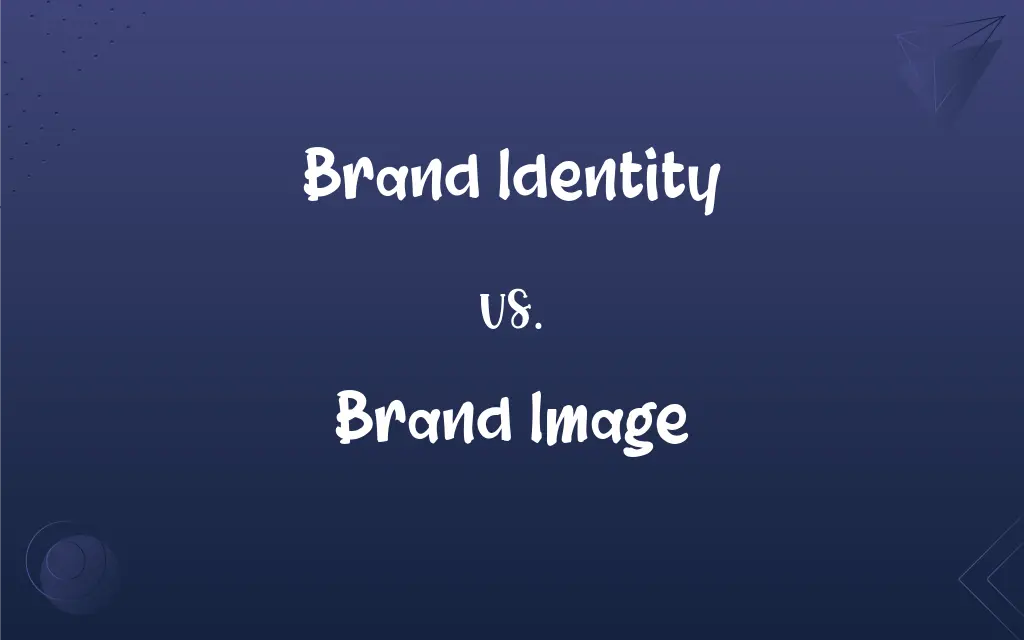Brand Identity vs. Brand Image: What's the Difference?
Edited by Aimie Carlson || By Harlon Moss || Updated on October 24, 2023
Brand identity is how a company presents itself, while brand image is how the public perceives it.

Key Differences
Brand identity represents the way a company wants to be viewed and understood in the market. It encompasses the intentional choices made by the business, such as logo design, color schemes, and messaging. Brand image, on the other hand, is how consumers and the general public actually perceive that business.
Brand identity is crafted meticulously by businesses to convey specific values, promises, and emotions. Every aspect, from typography to advertisements, is designed to showcase a consistent and recognizable identity. In contrast, brand image is the outcome of those efforts mixed with individual consumer experiences, perceptions, and interactions.
The essence of brand identity is control. Companies have the power to shape their identity, choosing what values to emphasize and how to represent them. Brand image, conversely, is something a company can influence but not directly control, as it's subject to personal interpretation and public opinion.
In essence, brand identity is the message a company sends out about itself, while brand image is the echo that comes back from the audience. If a brand's identity and image align, it indicates successful branding. However, discrepancies can suggest a need for rebranding or improved communication.
Comparison Chart
Control
Created and controlled by the company.
Shaped by consumers' perceptions.
ADVERTISEMENT
Formation
Deliberate choices: logo, colors, messaging.
Formed from experiences and interactions.
Purpose
To present the brand's vision and values.
Reflects how the public feels about the brand.
Stability
Relatively stable but can be redesigned.
Fluid and can change based on public opinion.
Outcome
A consistent presentation across platforms.
The cumulative opinion about the brand.
Brand Identity and Brand Image Definitions
Brand Identity
Brand identity encapsulates the tangible elements representing a brand.
Coca-Cola's red color and unique font underscore its iconic brand identity.
ADVERTISEMENT
Brand Image
Brand image is the public's perception of a brand.
Tesla's brand image is often associated with innovation and eco-friendly solutions.
Brand Identity
It's the consistent image a company projects across various platforms.
Nike's Just Do It slogan is a strong component of its brand identity.
Brand Image
Brand image reflects the emotions and beliefs consumers associate with a brand.
Disney's brand image resonates with magic, happiness, and childhood nostalgia.
Brand Identity
Brand identity is the visual and verbal presentation of a brand.
The golden arches are a key part of McDonald's brand identity.
Brand Image
Brand image is the mental picture held by consumers about a brand.
Rolex's brand image is synonymous with luxury and prestige.
Brand Identity
It's the intentional portrayal of a company's values and message.
Apple's sleek design and innovation emphasize its brand identity of forward-thinking technology.
Brand Image
It's the collective impressions formed from interactions with a brand.
Due to its customer service, Zappos has a positive brand image of reliability and care.
Brand Identity
Brand identity is the sum of all brand representations to convey its essence.
Starbucks' green mermaid logo and store design contribute to its comforting brand identity.
Brand Image
It's the outcome of all experiences, advertisements, and word-of-mouth related to a brand.
McDonald's brand image is often linked with fast service and childhood memories.
FAQs
What elements constitute brand identity?
Logo, color palette, typography, messaging, and design are elements of brand identity.
How is brand image formed?
Brand image is formed through consumers' experiences and perceptions of the brand.
Why might companies undergo a rebranding?
To modernize, target new markets, move past negative events, or better reflect their values.
Can a company control its brand identity?
Yes, a company has control over its brand identity, which it designs and presents.
Can a company control its brand image?
No, a brand image is influenced by the company but ultimately shaped by public perception.
How can a company improve its brand image?
Through positive customer experiences, consistent branding, and effective communication.
How do media coverage and reviews impact brand image?
They significantly influence public perception, either positively or negatively shaping brand image.
What is brand identity?
Brand identity is how a company presents itself, including its logo, colors, and messaging.
What's more important, brand identity or brand image?
Both are crucial; identity influences how a company wants to be seen, while image reflects how it's actually perceived.
Does brand identity influence customer loyalty?
Yes, a strong and consistent brand identity can foster trust and loyalty among customers.
Can a strong brand identity help in a crisis?
Yes, a well-established identity can act as a buffer, maintaining trust during challenging times.
How do consumer trends impact brand identity and image?
Companies might adapt their identity to stay relevant, and trends can shape public brand image perceptions.
Are brand identity and logo the same thing?
No, a logo is a component of brand identity, which encompasses a broader range of elements.
What happens if brand identity and brand image don't align?
Discrepancies can lead to brand confusion and may indicate a need for rebranding.
How do companies measure brand image?
Through surveys, feedback, social media monitoring, and analyzing customer reviews.
How do negative events affect brand image?
Negative events can tarnish brand image, sometimes requiring damage control or rebranding efforts.
How do endorsements and partnerships affect brand image?
They can enhance or harm brand image, depending on the alignment and reputation of endorsers/partners.
Why is brand identity important?
Brand identity creates recognition, differentiates from competitors, and communicates the brand's essence.
Can brand identity evolve over time?
Yes, companies may update or revamp their brand identity to stay relevant or reflect growth.
Are brand identity and company culture related?
Yes, a genuine brand identity often aligns with the company's internal values and culture.
About Author
Written by
Harlon MossHarlon is a seasoned quality moderator and accomplished content writer for Difference Wiki. An alumnus of the prestigious University of California, he earned his degree in Computer Science. Leveraging his academic background, Harlon brings a meticulous and informed perspective to his work, ensuring content accuracy and excellence.
Edited by
Aimie CarlsonAimie Carlson, holding a master's degree in English literature, is a fervent English language enthusiast. She lends her writing talents to Difference Wiki, a prominent website that specializes in comparisons, offering readers insightful analyses that both captivate and inform.







































































